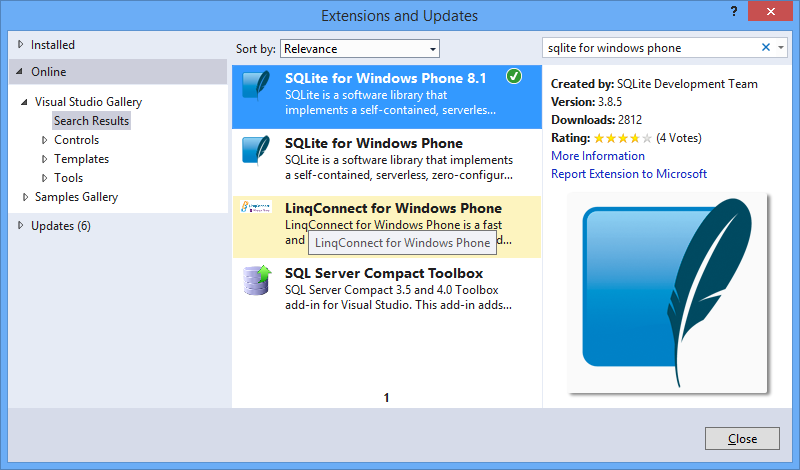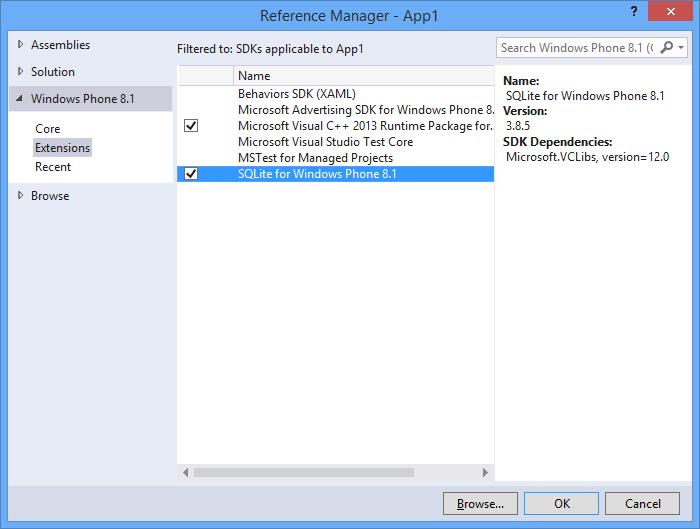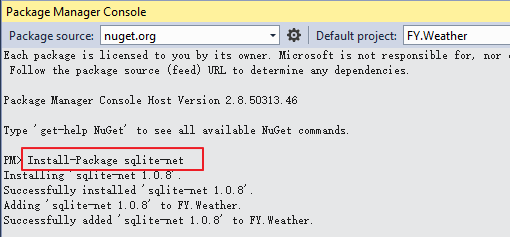SQLite是一个轻量级的关系型数据库,正是由于其精悍小巧,在移动端平台被广泛应用,但不适合处理大量数据和批量操作。它的底层是由C语言编写,最初设计是为了应用于嵌入式,占用资源非常低且简单易用,而且绝大部分程序语言都可以很好的与之结合。在.net中它的sdk中支持linq实现方式,使用更加方便。
sdk安装。

安装好了之后,我们引用dll。

这时候出现这样的错误,这是由于sdk只支持arm和32位的编译环境。

可以将通过项目属性将平台目标选为32位。
这里要说明一下,sqlite for wp8.1 sdk适用于32位和winrt,调试的时候可以选为32位,编译发布的时候,wp只能识别这个arm平台的环境。否则会报出 Error - Deployment optimization failed due to an assembly that's not valid. Try rebuilding the project, and then try again.

接下来还需要安装sqlite-net,可以这行package console的shell命令。

这时候我们的项目中会出现两个cs文件。

接下来我们来验证一下sdk,首先创建一个表对象。
1 using System; 2 using SQLite; 3 4 namespace FY.Weather.DataModel 5 { 6 [Table("Temp")] 7 public class Temp 8 { 9 [PrimaryKey, AutoIncrement] 10 public int Id { get; set; } 11 12 public string JsonData { get; set; } 13 14 public DateTime CreationDate { get; set; } 15 } 16 }
调用sdk创建表。
1 private async void CreateTemp() 2 { 3 string dbName = ViewModelLocator.Instance.DBName; 4 if (!await Common.CheckFileAsync(dbName)) 5 { 6 SQLite.SQLiteAsyncConnection conn = new SQLite.SQLiteAsyncConnection(dbName); 7 await conn.CreateTableAsync<Temp>(); 8 } 9 }
获取表数据。
1 private async System.Threading.Tasks.Task<Temp> GetTemp(int id) 2 { 3 SQLite.SQLiteAsyncConnection conn = new SQLite.SQLiteAsyncConnection(ViewModelLocator.Instance.DBName); 4 var query = await conn.QueryAsync<Temp>("select * from temp where id=?", new object[] { id }); 5 if (query != null && query.Count > 0) 6 { 7 return query[0]; 8 } 9 return null; 10 }
添加修改数据。
1 private async void AddOrEditTemp(Temp temp) 2 { 3 SQLite.SQLiteAsyncConnection conn = new SQLite.SQLiteAsyncConnection(ViewModelLocator.Instance.DBName); 4 var query = await conn.QueryAsync<Temp>("select * from temp where id=?", new object[] { temp.Id }); 5 if (query != null && query.Count > 0) 6 { 7 await conn.UpdateAsync(temp); 8 } 9 else 10 { 11 await conn.InsertAsync(temp); 12 } 13 }
验证数据库文件是否存在。
1 public static async System.Threading.Tasks.Task<bool> CheckFileAsync(string fileName) 2 { 3 bool fileIsExist = true; 4 try 5 { 6 Windows.Storage.StorageFile sf = await Windows.Storage.ApplicationData.Current.LocalFolder.GetFileAsync(fileName); 7 } 8 catch 9 { 10 fileIsExist = false; 11 } 12 return fileIsExist; 13 }